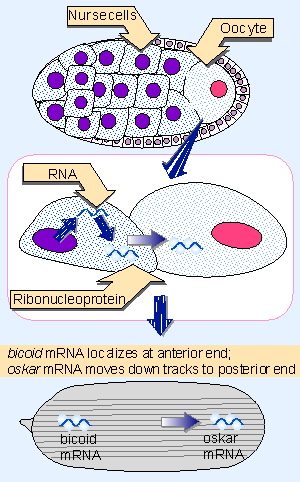8. Dorsal-ventral development uses localized receptor-ligand interactions
29.7 How are mRNAs and proteins transported and localized? |
Anterior and posterior development both depend on the localization of an mRNA at one end of the egg. How does the mRNA reach the appropriate location and what is responsible for maintaining it there? Similar processes are involved for both bicoid and oskar mRNAs. The sites of transcription are distinct from the sites where the mRNAs are localized and translated, and an active transport process is required to localize the mRNAs.
 |
Figure 29.10 Some mRNAs are transported into the Drosophila egg as ribonucleoprotein particles. They move to their final sites of localization by association with tracks that may be either either microtubules or actin filaments. Animated figure |
Both bicoid, oskar, and nanos all are transcribed in nurse cells. Figure 29.10 shows that mRNA is transported through the cytoplasmic bridges into the oocyte. Within the oocyte, bicoid mRNA then remains at the anterior end, but oskar mRNA is transported the length of the oocyte to the posterior end. The typical means by which an mRNA is transported to a specific location in a cell involves movement along "tracks", which may be either actin filaments or microtubules. This basically means that the mRNA is attached to the tracks by a motor protein that uses hydrolysis of ATP to drive movement (see the animation in Figure 29.10). In the example of the Drosophila egg, microtubules are the tracks used to transport these and other mRNAs (Pokrywka and Stephenson, 1995).
Genes whose products are needed to transport these mRNAs are identified by mutants in which the mRNAs are not properly localized. The most typical disruption of the pattern is for the mRNAs simply to be distributed throughout the egg. The best characterized of these transport genes are exuperantia (exu) and swallow (swa). Exu protein is part of a large ribonucleoprotein complex (). This complex assembles in the nurse cell, where it uses microtubule tracks to move to the cytoplasmic bridge (Theurkauf and Hazelrigg, 1998). Then it passes across the bridge into the oocyte in a way that is independent of microtubules. In the oocyte, it attaches to microtubules to move to its location.
We assume that different complexes transport different mRNAs, and that there must be a component of each complex that is responsible for targeting it to the right location. By following different mRNAs, it seems that in each the complex is transported to the anterior end of the oocyte, where it aggregates. Then a decision is made on further localization, and the complex is transported to the appropriate site.
We know that the localization of the bicoid RNA to the anterior end of the oocyte depends upon sequences in the 3′ untranslated region (Driever and Nusslein-Volhard, 1988; Driever and Nusslein-Volhard, 1988). This is a common theme, and localization of oskar and nanos mRNAs is controlled in the same way (Gavis, Curtis, and Lehmann, 1996). We assume that the 3′ sequences provide binding sites for specific protein(s) that are involved in localization. Corresponding sequences in each mRNA will provide binding sites for different proteins that target to the appropriate sites in the oocyte.
The properties of exu and swa mutants show that there are common components for the transport and localization of different mRNAs. We do not yet know what differences exist between the complexes involved in transporting different mRNAs.
Localization of RNAs may not be sufficient to ensure the pattern of expression. Translation may also be controlled. The production of oskar and nanos proteins is controlled by repression of the mRNAs outside of the posterior region. In each case, translation is repressed by a protein that binds to the 3′ region (Kim-Ha, Kerr, and MacDonald, 1995). In the case of nanos, it has not been possible to disentangle the elements required for localization and repression, suggesting that they may be part of the same mechanism (Gavis, Curtis, and Lehmann, 1996; Dahanukar and Wharton, 1966).
This section updated 4-25-2000
| Research | |
| Dahanukar, A. and Wharton, R. (1966). The nanos gradient in Drosophila embryos is generated by translation regulation.. Genes Dev. 10, 2610-2620. | |
| Driever, W. and Nusslein-Volhard, C. (1988). A gradient of bicoid protein in Drosophila embryos. Cell 54, 83-93. | |
| Driever, W. and Nusslein-Volhard, C. (1988). The bicoid protein determines position in the Drosophila embryo in a concentration dependent manner. Cell 54, 95-104. | |
| Gavis, E. R., Curtis, D., and Lehmann, R. (1996). Identification of cis-acting sequences that control nanos localization. Dev. Biol. 176, 36-50. | |
| Gavis, E. R., Curtis, D., and Lehmann, R. (1996). A conserved 90 nucleotide element mediates translational repression of nanos RNA.. Development 122, 2791-2800. | |
| Kim-Ha, J., Kerr, K., and MacDonald, P. M. (1995). Translational regulation of oskar mRNA by bruno, an ovarian RNA-binding protein, is essential.. Cell 81, 403-412. | |
| Pokrywka, N. J. and Stephenson, E. C. (1995). Microtubules are a general component of mRNA localization systems in Drosophila oocytes. Dev. Biol. 167, 363-370. | |
| Theurkauf, W. E. and Hazelrigg, T. I. (1998). In vivo analyses of cytoplasmic transport and cytoskeletal organization during Drosophila oogenesis: characterization of a multi-step anterior localization pathway.. Development 125, 3655-3666. | |
| Wilhelm, J. E. et al. (2000). Isolation of a ribonucleoprotein complex involved in mRNA localization in Drosophila oocytes.. J. Cell Biol. 148, 427-439. | |